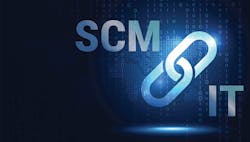Supply Chain & IT: Collaboration at first byte?
Supply Chain and Information Technology (the IT department) consistently have engendered a love-hate relationship. To succeed, Supply Chain needs IT expertise to manage and track the myriad transactions and products that flow through the department; at the same time, IT wants control over most, if not all, electronic connectivity within a healthcare organization for operational and security purposes.
For Supply Chain, IT is a tool; unfortunately for IT, Supply Chain can be a tool, too, in terms of attitude rather than function.
If Supply Chain, which also should oversee purchased services on behalf of IT and other departments, controls at least 50 percent of a healthcare organization’s expense stream, it only makes sense that they should be IT-enabled and IT-savvy – whether by their own staff or by relying on IT assistance.
So how do – or should – these two departments amicably work together?
Form follows function
Some may argue against siloes or walls between departments and functions in the name of cooperation and transparency, but certain barriers exist for logical reasons.
The first may be linked to corporate hierarchy, positioning on the C-suite ladder.
“The two departments are not integrated,” Mazzei- Williams told Healthcare Purchasing News. “I have found one IDN out of hundreds that I have worked with over the years where Supply Chain and IT exist in the same building and report to the same C-Suite position. Most organizations have Supply Chain report to the CFO, while IT reports to the CIO. This inherently creates a divide if the foundation and infrastructure is not aligned appropriately from the top, down and then across the divisions as well.”
The second may involve technological security and traffic copping conflicts.
“The IT department is responsible for keeping the IT infrastructure safe,” Mazzei-Williams continued. “Supply Chain tends to have data coming in from various entities as well as being shared to various entities. This creates a potential IT hazard. Sometimes Supply Chain works around IT to not hit the red tape; other times they follow protocol and go through IT. But with many competing projects, collaborating with IT can indeed slow down the supply chain projects – again creating a rub between the two sides. Supply Chain is trying to save the organization money, but if projects are bogged down, this can slow down the productivity and savings.”
The third may point to priorities and resource availability.
“There never seems to be enough resources on the IT side to get done what needs to get done,” she indicated. “Between entire system upgrades that often take years to complete to everything else in between, bandwidth can be limited. I can’t even begin to tell you how many times I’ve gone into a discussion on a savings opportunity, and the first thing out of Supply Chain is ‘If this needs to go through IT, we can’t look at it for X weeks, months, etc., because they are bogged down with X and short on resources. While this can be smoke and mirrors in some instances, in the majority of situations it has been true. When Supply Chain has savings goals and IT seems to be a potential roadblock, Supply Chain will work around it if they can find a way. While this may seem to be a short-term fix, it doesn’t bode well for improving collaboration in the future.”
“If a business team in Supply Chain sees IT as a service provider or order taker and not as a true partner, there is a limit to what can be achieved,” Mackey noted. “I recall a situation earlier in my career, dealing with a constant complaint that our IT team within the organization was not delivering enough support or quickly enough. I wanted greater control of the tools in place to assist in contracting, procurement and to conduct spend analytics. I recall a heated discussion with our then-CIO where I demanded better service as his customer. He pounded his fist on the table asserting that I was not his customer – I was his partner. As Supply Chain struggles to get out of the basement, the same struggle for both service functions exists to best partner with functions across the organizations and not be limited.”
“As technology has changed and matured, the way Supply Chain and IT departments collaborate should have evolved,” Amell indicated. “ Gone are the days where technology drives business process. In today’s world of modern functionality and ability to access data, technology should enable and support business process. Supply Chain tends to be resistant because most IT departments have not progressed to a service/support model and do not view Supply Chain as an internal customer.”
Historically, the two departments have been at odds or have competed for time but Cameron McEwen, Senior Market Manager, Global Provider, GHX, maintains hope and sees a bright side within providers to their collaborating.
McEwen recognizes, however, that in some cases Supply Chain continues to struggle for relevance.
“Part of this issue stems from the fact that the Supply Chain is still working to gain respect and support from senior hospital leaders,” he said. “Oftentimes, hospital purchasing departments are located in the basement of a facility, literally the dungeon of a hospital. Sometimes, Supply Chain leaders are not consulted on big decisions being made in their organizations, even things that directly impact the supply chain, such as which ERP platform a hospital purchases.
“All this creates an environment where Supply Chain feels like the ‘red-headed step child,’ creating a constant battle between Supply Chain and IT,” he continued. “Supply Chain perceives IT as a department that’s impeding its ability to achieve key goals – and, in turn, IT feels put-upon with too many seemingly random requests that seem disconnected from its main business priorities. But as organizations increasingly understand the business value Supply Chain can deliver, and as Supply Chain gains respect as a critical organizational function, the partnership between Supply Chain and IT is improving.”
Finding common ground
“These teams often find themselves at odds because they don’t equally understand the capabilities – and limitations – of their current EMR or ERP systems,” Freund said. “IT often discounts or doesn’t even consider the needs of Supply Chain when selecting an ERP or EMR system. Thus, Supply Chain is often left with a system that does a great job of helping with the needs of purchasing, but lacks in the functionality of actually managing inventory once inside the hospital. It is important that Supply Chain educates IT on their inventory workflows, the challenges they face when trying to reduce inventory, and the labor associated with handling it. They need to help IT understand the challenges they have in managing physician preference items, tracking implants and the vendors that sell them to the hospital, and ensuring that chargeable items consumed are actually billed properly.
“We have found that when properly educated on supply chain challenges, IT can be a great partner to work with to help solve problems,” he added.
“For many Supply Chain folks, the operational aspect of their jobs do not translate well into software processes, which can lead to confusion around the desired outputs,” Pakieser said. “It is a scenario I have seen played out more often than not; what the Supply Chain professional defines as their desired end-state does not translate well into the solution delivered by their IT counterparts. By not working together to understand the challenges each department faces, solutions are siloed and disconnected, and lead to intradepartmental frustration.”
Resource access and workload can affect the professional relationship, too, she indicated.
“If IT is centrally managed, they are dealing with all the software and technology support across the enterprise,” she said. “This includes clinical, business, records, facilities, ERP, EHR and other operational needs. Now, let’s expand that to include care delivery areas outside the acute care setting! In this scenario, Supply Chain may not feel they are getting the support they need from their IT colleagues for departmental initiatives. One way to mitigate this resource allocation challenge is to hire a person – or team – that is dedicated to Supply Chain, much like Supply Chain has embedded staff in procedural areas to provide dedicated support. This has been a successful resolution for some health systems.” [Editor’s Note: For a relevant, top-notch and workable example, see Tower Health, HPN’s 2019 Supply Chain Department of the Year, by visiting https://www.hpnonline.com/21087717.]
“The typical health system has hundreds of software products in their ecosystem,” Spriggs said. “It is incumbent on the IT team to synergistically secure all that data, support the overall infrastructure and deliver on service level agreements. If prospective systems expose the organization to some type of risk, IT objections can sometimes be misinterpreted by the business as impediments to agility. In the end, this important due diligence serves to protect all parties from many nasty outcomes; think litigation, HIPAA violations, down-time, opportunity cost – and most importantly – risk to patients’ safety. Collaboration, planning and communication at the senior leadership levels of both IT and Supply Chain can quickly break down any barriers that may exist, creating a powerful partnership for success.”
Expanding influence
Experts alternatively express support for or misgivings about strategies and tactics to bridge the gap between Supply Chain and IT, while agreeing, however, that the gap is not insurmountable. Whether hiring dedicated staff members to manage and oversee supply chain IT – be they data analysts, data scientists or programmers – or using expertise from consulting firms, GPOs or other third-party product and service companies, reactions are mixed.
Think temp, according to TRIOSE’s Mazzei-Williams.
“I do believe that for larger projects, adding some short-term help is probably beneficial, especially if the employees won’t be needed long-term,” she noted. “Better to add some consultants either from the organization you are buying services from, your GPO, or another provider, than to add head count only to be laid off at another time. Many IDNs are adding data scientists as data is becoming more important in decision making. These analysts assist Supply Chain in number crunching and can build credibility for savings opportunities and calling attention to the needs to get the projects pushed through more quickly.”
Staffing for Supply Chain IT may solve a critical communication concern, GHX’s McEwen suggested.
“Supply Chain and IT often don’t speak the same language, which makes it hard for IT to appreciate the value or urgency of the ‘ask’ the Supply Chain is making to them,” he said. “If Supply Chain can employ professionals on its teams who can ‘talk the IT talk,’ these individuals can play a critical role in imparting the value of what Supply Chain is trying to achieve and help boost an ask higher on IT’s priority list.”
McEwen points to Supply Chain’s increasing alignment with Value Analysis departments and professionals as a noteworthy example.
“Hospitals in the past were eliminating data analysts as part of cost cutting initiatives, but now the scale is tipping in the other direction as the value of this role becomes more critical and acknowledged,” he noted. “In today’s robust hospital M&A environment, providers are dedicating more resources and dollars to build out teams populated by analysts who can crunch data. Having analysts who can deliver data directly to the supply chain helps lessen some of IT’s burden so IT teams can be leveraged for more strategic requests.”
McEwen acknowledges that GPOs are helping, too, by striving to add value to their membership and customer bases by offering services that address data issues typically submitted to IT and easing the burdens and expectations placed on them. Further, third-party organizations, including consultants and product and service companies, contribute by supporting [key performance indicator] reporting through reviewing, mining and sharing relevant data findings, he added.
For Infor’s Amell, Supply Chain simply needs to assert some control.
“Supply Chain should own the business operations and relationships of core Supply Chain functions in [the] healthcare organization,” she said. “Many organizations have progressed to this model where data analyst and scientist reside in the Supply Chain department. In a smaller organization those economies of scale might not be available and resources might need to be shared. As cloud software continues to grow and become more prevalent, many IT departments are going to be challenged to redefine their roles in a healthcare organization. A different skill set will be needed. An example would be a transition to data science, AI and machine learning.”
JumpTech’s Freund, however, doesn’t believe providers must stock up on data analysts or scientists because a number of software companies already are fortified with these pros and have created useful applications to develop and fortify clinically integrated supply chains.
“Leveraging third parties, like GPOs or other consulting organizations, can help Supply Chain make informed decisions based on the data their software applications provide,” he said. “IT has to recognize that ERP and EMR systems are very good at their core functionality, but like every enterprise system, they leave gaps that can be filled by other software providers in the market. Being open to integrating these solutions into the existing hospital infrastructure is key to driving savings and improving patient care; although IT understandably wants to minimize the number of systems that require integration.
“However, when you consider studies that have shown a typical hospital misses up to 30 percent of charge capture due to complicated workflows and lack of system integrations, it becomes clear that these additional solutions that can help fix those problems should be considered,” he continued. “We have found that when properly educated, IT can be a great partner to help identify and bring those solutions in house.”
Flexibility and speed should drive decisions on potential solutions, Intalere’s Mackey insists.
“The best approach is to deliver a strong partnership model where processes are well defined and needs clearly articulated,” he said. “The need to best analyze spend and detailed data for better category strategies and value capture is more important now than it was five years ago. Data lives in distinct systems and applications across the organization. There can also be a trap that nobody knows the organizational need or the requirement as well as Supply Chain, so they can sometimes not realize, or discount the true value third-party expertise from a consulting firm or a GPO can bring. The trap is that while no one knows your organization better than you, it is a complete mistake to think that best practices from a third-party aren’t critically valuable. Best practices from suppliers, partners, and other providers are an important part of partnering with organizations to deliver value.”
TECSYS’ Spriggs emphasizes a more holistic approach that unites thinking.
“Without a doubt, conflicting priorities and misalignment of goals and objectives plague many organizations,” he noted. “Busywork needs to be filtered from important work through value-based analysis. By prioritizing the work that drives the most value for the business and by agreeing on common objectives, these teams will work toward more successful outcomes. This ‘good-business-practice’ of creating alignment within the organization applies to all teams, both inside and outside of the organization.”
Supply Chain-IT alignment strategies offer more byte than bark
When encouraging and navigating Supply Chain to collaborate with Information Technology and vice versa, what strategies and tactics make for long-term vs. short-term improvements? Seven experts share their recommendations.
“Collaboration and trust are the key to long-term improvement from both departments. The two departments are integral to the operations of any health system and thus need to play in the same sandbox often. Short-term improvements can often be made by tweaking processes or identifying challenges and working together for solutions; but long-term collaboration will be reliant on trust and a positive culture.”
Nicole Mazzei-Williams, CMRP, FAHRMM, National Enterprise Account Manager, TRIOSE
“Most hospitals we talk to have short-term goals of reducing inventory and the labor associated with managing supplies. This can be done by integrating solutions that provide data to help manage how much inventory should be on shelves; this is a typical gap found in most ERP systems. For long-term improvements, Supply Chain should look to automate systemic problems in the hospital. This would include implementing solutions that help systemically manage physician preference item or drive standardization by eliminating both clinical and operational variances or reducing the amount of time nurses spend documenting cases so they can spend more time with patients.”
John Freund, President and CEO, Jump Technologies Inc.
“Short-term improvements relate to defined processes for support and service delivery with specific key performance indicators (KPIs) and defined service level agreements (SLAs). In this way, service delivery can be measured and understood in the short run to make sure what’s needed is provided. In the longer term, a strong and healthy partnership between the two functions is most valuable with shared objectives so that both functions hold a shared goal and figure out the best way to integrate their work together.”
Richard Mackey, Senior Vice President of Information Technology, Intalere
“The supply chain is working to play a larger role in C-suite initiatives where it can lend tremendous insights in the support of key trends, such as the shift to value-based care, along with the movement to better integrate the supply chain with a hospital’s clinical staff. Aligning with initiatives that matter to C-level leaders is helping Supply Chain get more time at the table and elevate its business presence. It’s only natural that as Supply Chain gains more strategic visibility and lives higher up in the hospital operational chain than previously, it will get more attention from IT. No longer is Supply Chain just viewed as the department where you ‘go to get a widget.’”
Cameron McEwen, Senior Market Manager, Global Provider, GHX
“Clearly defined roles/scope, establishing business process ownership, and reallocation of resources. Many organizations will work differently in the cloud, and the skill set required will be unlike what was required in the past.”
Melissa Amell, Industry & Solution Strategy Director, Infor Healthcare
“There is no silver bullet, of course. But like most complex situations, communication and a desire for collaboration go a long way in addressing both short- and long-term improvements. An example of success is the move to a clinically integrated supply chain that we see happening across the market. It extends well beyond just Supply Chain and IT, including clinical, finance, leadership, and so on. By bringing appropriate representation to the table, providing clear direction and allowing them to create the process and flow that works for their organization, health systems are making significant strides in this area.”
Nancy Pakieser, Senior Director, Industry Development, TECSYS
“Aligning goals at the corporate level, at the team level, and on the individual level creates amazing results. To foster this kind of alignment, I suggest looking into the Objectives and Key Results (OKR) goal setting methodology. Many successful corporations, including TECSYS, use this methodology to create common goals throughout the organization. Starting an OKR program sounds easy, and can result in immediate gains, but it does take time and some know-how to refine the process in order to get maximum results. There are myriad other tools to help in the discipline of keeping everyone focused and on track – just ask Google – but the key is to do it right. Even the best tactic will fail if stakeholders are not bought in on the strategy.”
Glenn Spriggs, Director, Product Management, TECSYS
When Supply Chain-IT collaborate, organizations elevate
Six Supply Chain IT experts recount successful team-ups between the two departments.
“In one IDN, Supply Chain and IT worked well together from the start of our project there, and the health system almost doubled their projected savings within the first year. This is because the two departments were used to working side-by-side on initiatives and were on the same page from the very beginning. This collaboration allowed our organization to process the data we needed to process more quickly as we weren’t chasing the data.”
Nicole Mazzei-Williams, CMRP, FAHRMM, National Enterprise Account Manager, TRIOSE
“Children’s Mercy Hospital in Kansas City, MO, is a good example of an effective Supply Chain-IT relationship. Jump Technologies began working with Children’s in 2016, when supply chain leadership realized they needed a solution that would help reduce inventory without adding tasks to nursing. After conducting a thorough supply chain review process that was part of the organization’s overall Lean initiative, Children’s chose to implement a kanban approach with Jump Technologies, and we have worked closely with their IT team to integrate JumpStock into their Lawson platform to create a seamless, demand-driven supply chain. As a result of their internal collaboration and the integration of JumpStock, Children’s has realized several important outcomes, including:
- Time savings – Time to restock the hospital’s PAR walls has been reduced to less than 15 minutes;
- Improved workflows – Aligning supply chain with clinical workflows reduced the time it takes for nurses to find their first item by nearly 85 percent, while reducing order time for Supply Chain staff by 80 percent and reducing the time it takes to reorder PAR wall to approximately 5 minutes;
- Lower supply spend – Reorganization in supply rooms has allowed Children’s Mercy to reduce inventory by an average of $15,000 in each of the first five rooms where the flipper bin system was implemented;
- Fewer stockouts – As the data delivered by the reporting capabilities of JumpStock paints a clearer picture of actual supply use, the hospital has increased ordering frequency from every two or three days, to daily orders of smaller quantities. Stockouts are also down significantly under the new system;
- Less inventory sitting on shelves – JumpStock has allowed Children’s to reduce on-hand inventory by 12 percent and reduce inventory on PAR walls by 9 percent.
John Freund, President and CEO, Jump Technologies Inc.
“We were looking to redesign our procurement tools to better integrate with our ERP. We found that services procurement and electronic invoicing could help us to transform our procure-to-pay cycle within the company. There was a breakdown initially between Supply Chain and IT where blocks and obstacles were being identified by both parties. Ultimately, the lack of a partnership between the two teams was addressed by bringing both groups together for a period of frequent facilitated off-sites over several months. Being able to reframe the need and the priorities between both teams allowed for a breakthrough to occur where common ground could be found and identified through a better understanding of the teams’ goals. Ultimately, the project was implemented and allowed the company to transform its procure-to-pay capabilities.”
Richard Mackey, Senior Vice President of Information Technology, Intalere
“Early on in my career I was fortunate enough to work with a great team of IT professionals where operations were approached as a true collaboration. IT owned the technical aspects of the business systems, and I as a former Director of MMIS owned the data and functional aspects of the system as a department and business owner. Both departments had clearly defined roles and objectives and we were able to work together to execute, which resulted in customer satisfaction to the departments we supported in the overall healthcare organization. Based on newer functionality that is available today, I likely would be structured and work very differently with IT than I did in the past.”
Melissa Amell, Industry & Solution Strategy Director, Infor Healthcare
“One prime example of this kind of collaboration is the team at Mercy in St. Louis. As Betty Jo Rocchio [Chief Nursing Optimization Officer] began to address preference card management, she had an ‘Aha!’ moment with her colleague Matt Mentel [System Executive Director, Business Integration] when she realized what she was managing was a supply chain problem. From that point forward, she engaged with Supply Chain and other departmental stakeholders in IT and finance to design and implement processes that supported clinical care delivery by leveraging the strength of each functional area. It has been a terrific, clinically-driven, operationally-led success!”
Nancy Pakieser, Senior Director, Industry Development, TECSYS
“A marker of success for us as a supply chain software provider is when these two departments work in perfect lockstep. For example, IT and Supply Chain collaboration is paramount in integrating the EMR with supply chain software to retain a common workflow for clinicians while supporting supply chain inventory management processes. We work on complex projects like implementation of self-distribution projects and in-hospital supply chain solutions that extend into perioperative areas like the OR and cath lab; on a regular basis, we witness and foster collaboration between Supply Chain and IT and see positive business outcomes like cost containment, new revenue capture, reduced expiry and safeguards for patient safety.”
Glenn Spriggs, Director, Product Management, TECSYS
About the Author
Rick Dana Barlow
Senior Editor
Rick Dana Barlow is Senior Editor for Healthcare Purchasing News, an Endeavor Business Media publication. He can be reached at [email protected].








